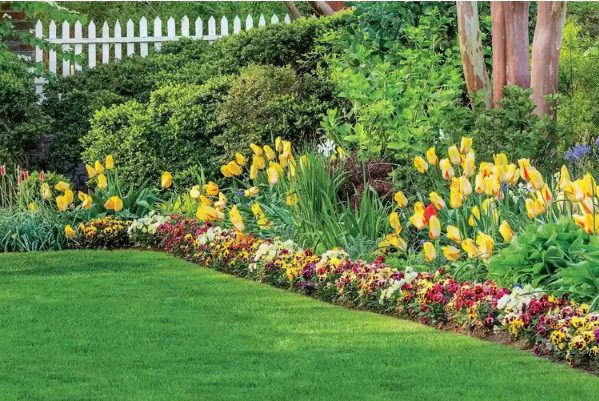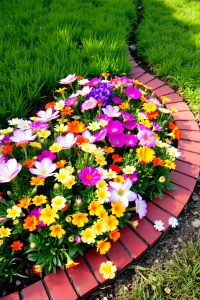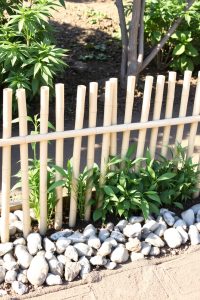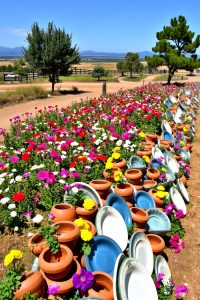
10 Creative Ideas to Edge Your Garden with Style

A garden edge does more than just separate soil from lawn—it adds shape, beauty, and structure.
A well-defined border gives your outdoor space a polished look and keeps everything neat.
From natural materials to modern touches, edging can bring out the character of your garden and highlight its best features.
Neatly lined borders also help control weeds and stop mulch or gravel from spilling into unwanted areas.
You can match the edge to your garden’s theme or try something bold to make it stand out.
Whether you’re working with a flower bed, veggie patch, or decorative landscaping, the right edge makes a big difference.
Some edging ideas use items you might already have at home, while others bring a sleek or rustic charm with minimal effort.
Explore these 10 ideas to find the perfect fit for your garden style—each one adds both function and flair to your outdoor space.
10 Ideas for Edging a Garden
A garden edge does more than mark a boundary. It shapes your outdoor space. It keeps things tidy. It brings order and beauty together.
A clean edge can stop grass from spreading into flower beds. It can help gravel or mulch stay in place. And it makes your garden look complete.
There are many ways to edge a garden. Some are made from natural materials. Others use things you might already have.
You can build it yourself or buy ready-made borders. From bricks and stones to metal and wood, garden edging comes in many styles.
Let’s explore 10 ideas for edging a garden. Each one brings a different look. Each one can make your garden stand out.
1. Brick Edging

Brick edging brings structure and charm to any garden. It works well in both modern and traditional settings.
Bricks are strong, easy to find, and last for many years. You can use old or new bricks depending on the style you want.
Lay bricks flat for a smooth, low edge. Stand them upright for a taller look. Try different patterns, such as straight lines or zig-zags.
You can even combine brick with gravel or mulch for extra detail. Bricks stay in place without much shifting.
You can also add a bit of cement or sand underneath for support. Use a shovel to dig a small trench and set the bricks in a row.
This keeps your edge neat and level. Brick works well around flower beds, trees, or paths. It adds a clear boundary that also looks nice year-round.
2. Stone Edging
Stone edging adds a natural and timeless look. Use flat rocks, river stones, or large rough stones. Each one has a different shape and texture,
which makes your garden feel unique. Stone edges look great in gardens with lots of green, wildflowers, or water features.
Large stones make strong edges that won’t move easily. Smaller ones add soft curves and blend in with grass or soil.
Pick stones that match the color of your garden or home. Gray, tan, and brown stones work with most plants.
Stack them in one or two layers. Or leave small gaps between them for a looser feel. Stone edges don’t need glue or cement.
Just dig a shallow trench and press the stones in. This lets water drain well and keeps roots from spreading.
Over time, moss may grow on the stones, which adds more beauty.
3. Wood Log Edging

Wood log edging gives a cozy, natural look. Use thick branches, cut logs, or wood rounds from tree trunks.
This type of edging fits well in gardens with mulch paths, forest plants, or rustic designs.
Cut the logs to the same height for a clean line. Place them upright, side by side. You can also lay them flat or stack them.
Use garden spikes to hold the wood in place if needed. Logs break down over time. So use treated wood or cedar, which lasts longer.
To protect the base, place a layer of gravel or sand below the logs. This stops moisture from staying trapped.
Wood log edging is good for vegetable beds, flower borders, and herb gardens. It adds height and texture while blending with the soil and plants around it.
4. Concrete Borders
Concrete borders make a bold, long-lasting edge. This style works in formal, modern, or clean garden designs.
It keeps mulch, soil, and gravel in place and stays strong for years. Pre-made concrete blocks come in many shapes and sizes.
Some are round, square, or curved. You can also pour your own concrete into a mold. Use a simple form or choose one with a pattern.
Stamp designs into wet concrete or mix in color for a custom look. Some people mix concrete with stones or pebbles for texture.
Once it sets, the edge becomes very hard and stable. Concrete borders work best around lawns, patios, and raised beds.
They stop roots and grass from spreading. They also add a nice frame to the garden that stands out without being too flashy.
5. Metal Edging
Metal edging gives your garden a sharp, clean edge. It works best in modern or minimalist spaces.
The thin profile makes it nearly invisible, but it still keeps plants and grass apart.
Steel, aluminum, and copper are common types. Steel is strong and dark. Aluminum is lighter and won’t rust.
Copper changes color over time and adds an artistic touch.
Bend the metal to follow curves or leave it straight. Use metal stakes or clips to keep the edge in place.
The metal edge sits partly in the soil, with a small lip above the ground.
This style suits gardens with gravel, stone, or trimmed lawns. It works well for flower beds, tree rings, and paths.
The edge keeps everything in place and makes the garden look neat.
6. Recycled Bottle Edging

Recycled bottles bring color and creativity to your garden. Use wine bottles, soda bottles, or glass jars.
Choose clear or colored glass to match your plants and garden style.
Wash the bottles and remove labels. Dig a shallow trench along the garden edge. Place the bottles upside-down, with the neck buried in the soil.
Leave a few inches of the base showing above the ground. Mix and match colors for a rainbow look. Or keep one color for a clean, simple line.
Glass bottles shine in sunlight and add fun to the space. They also work well around herb gardens, kids’ spaces, or creative corners.
This type of edge is low-cost and eco-friendly. It’s a smart way to reuse what you already have. Add solar lights nearby to make the bottles glow at night.
7. Plastic Landscape Edging
Plastic edging is easy to use and budget-friendly. It bends well and works for all shapes of garden beds. It comes in rolls or strips that you can cut to size.
Lay the plastic edge in a trench and push stakes into the ground. Some types have a top edge that sticks above ground. Others stay hidden for a low-profile look.
Black plastic is the most common, but you can find brown or green to blend with soil and grass.
Plastic holds mulch, gravel, and soil in place. It also helps stop weeds from creeping in.
Use this type of edge around flower beds, driveways, or walkways. It’s light, simple, and easy to change if needed.
8. Bamboo Edging

Bamboo edging brings peace and beauty to the garden. It fits best in Zen, Asian, or tropical-style gardens.
Bamboo is light but strong. It also resists insects better than some woods. Buy bamboo poles or cut your own.
Use short pieces about 6 to 12 inches long. Tie them with string or garden wire in groups. Place them in a line with the base in a trench.
You can also use rolled bamboo fencing cut to the right height. Push stakes in the ground behind the bamboo to keep it from moving.
This edge looks great around flower beds with stones, moss, or leafy plants. It adds texture and a calm, earthy tone to the garden.
9. Gravel or Pebble Trenches
Gravel and pebbles make a soft and open border. This type of edge is great for water flow and drainage. It also helps stop mud and keeps your garden beds clean.
Dig a trench along the edge of your garden. Make it about 4 to 6 inches wide and deep. Fill it with gravel, pebbles, or small stones.
Choose a color that fits your plants or nearby paths. White stones brighten dark spots. Gray or brown stones feel more natural.
Mix large and small pebbles for texture. This edge looks great around cactus beds, dry gardens, or modern landscapes.
You can use edging strips on both sides of the trench to hold the gravel in place. Or leave it open for a more natural look.
10. Repurposed Material Edging

Old items can turn into fun, low-cost garden edges. Use what you have at home or find items at flea markets or yard sales.
Broken plates, old roof tiles, seashells, or even bike tires can work.
Place them side by side to form a border. Mix shapes, colors, and materials for a playful edge. Use strong glue or stakes to help hold them in place.
This edge brings personality and charm. It fits well in artsy, cottage, or family gardens. It also teaches reuse and makes gardening fun for kids.
Try lining a garden bed with old teacups, pieces of tile, or colorful plastic toys. It gives your space a one-of-a-kind look and sparks conversation.
FAQs
What is the cheapest way to edge a garden?
Plastic edging, recycled bottles, and repurposed materials are often the least expensive options. They are easy to find and simple to install.
How deep should garden edging go?
Most edging goes 4 to 6 inches deep. That helps it stay in place and blocks roots or grass from spreading.
Which edging lasts the longest?
Concrete and metal edges last the longest. They resist weather, water, and wear over time.
Can I install garden edging myself?
Yes, many edging types are easy to install without help. Some need a shovel, level, and stakes. Others just need a small trench and time.
Does edging stop weeds?
Yes, edging helps block grass and weeds from spreading into your garden beds. It also keeps mulch or gravel where it belongs.
Conclusion
Garden edging brings more than just neat lines. It gives shape, structure, and style to outdoor spaces. Each edge tells a different story.
Brick feels classic. Stones feel natural. Metal feels clean and sharp. Even broken pots or bottles can bring charm.
You don’t need a big budget or fancy tools. You just need a bit of time and the right idea for your space.
Try one of these 10 ideas and give your garden a tidy, beautiful edge that feels just right. A good border is like a picture frame—it makes everything inside look better.
